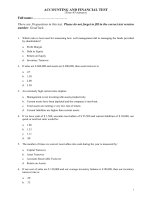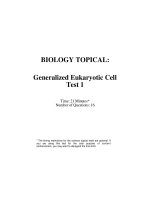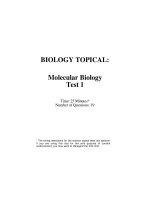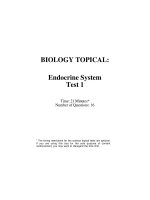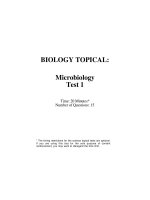1Separations and purifications test w solutions
Bạn đang xem bản rút gọn của tài liệu. Xem và tải ngay bản đầy đủ của tài liệu tại đây (75.6 KB, 12 trang )
ORGANIC CHEMISTRY TOPICAL:
Separations and Purifications
Test 1
Time: 22 Minutes*
Number of Questions: 17
* The timing restrictions for the science topical tests are optional. If
you are using this test for the sole purpose of content
reinforcement, you may want to disregard the time limit.
MCAT
DIRECTIONS: Most of the questions in the following
test are organized into groups, with a descriptive
passage preceding each group of questions. Study the
passage, then select the single best answer to each
question in the group. Some of the questions are not
based on a descriptive passage; you must also select the
best answer to these questions. If you are unsure of the
best answer, eliminate the choices that you know are
incorrect, then select an answer from the choices that
remain. Indicate your selection by blackening the
corresponding circle on your answer sheet. A periodic
table is provided below for your use with the questions.
PERIODIC TABLE OF THE ELEMENTS
1
H
1.0
2
He
4.0
3
Li
6.9
4
Be
9.0
5
B
10.8
6
C
12.0
7
N
14.0
8
O
16.0
9
F
19.0
10
Ne
20.2
11
Na
23.0
12
Mg
24.3
13
Al
27.0
14
Si
28.1
15
P
31.0
16
S
32.1
17
Cl
35.5
18
Ar
39.9
19
K
39.1
20
Ca
40.1
21
Sc
45.0
22
Ti
47.9
23
V
50.9
24
Cr
52.0
25
Mn
54.9
26
Fe
55.8
27
Co
58.9
28
Ni
58.7
29
Cu
63.5
30
Zn
65.4
31
Ga
69.7
32
Ge
72.6
33
As
74.9
34
Se
79.0
35
Br
79.9
36
Kr
83.8
37
Rb
85.5
38
Sr
87.6
39
Y
88.9
40
Zr
91.2
41
Nb
92.9
42
Mo
95.9
43
Tc
(98)
44
Ru
101.1
45
Rh
102.9
46
Pd
106.4
47
Ag
107.9
48
Cd
112.4
49
In
114.8
50
Sn
118.7
51
Sb
121.8
52
Te
127.6
53
I
126.9
54
Xe
131.3
55
Cs
132.9
56
Ba
137.3
57
La *
138.9
72
Hf
178.5
73
Ta
180.9
74
W
183.9
75
Re
186.2
76
Os
190.2
77
Ir
192.2
78
Pt
195.1
79
Au
197.0
80
Hg
200.6
81
Tl
204.4
82
Pb
207.2
83
Bi
209.0
84
Po
(209)
85
At
(210)
86
Rn
(222)
87
Fr
(223)
88
Ra
226.0
89
Ac †
227.0
104
Rf
(261)
105
Ha
(262)
106
Unh
(263)
107
Uns
(262)
108
Uno
(265)
109
Une
(267)
*
58
Ce
140.1
59
Pr
140.9
60
Nd
144.2
61
Pm
(145)
62
Sm
150.4
63
Eu
152.0
64
Gd
157.3
65
Tb
158.9
66
Dy
162.5
67
Ho
164.9
68
Er
167.3
69
Tm
168.9
70
Yb
173.0
71
Lu
175.0
†
90
Th
232.0
91
Pa
(231)
92
U
238.0
93
Np
(237)
94
Pu
(244)
95
Am
(243)
96
Cm
(247)
97
Bk
(247)
98
Cf
(251)
99
Es
(252)
100
Fm
(257)
101
Md
(258)
102
No
(259)
103
Lr
(260)
GO ON TO THE NEXT PAGE.
2
as developed by
Separations and Purifications Test 1
Passage I (Questions 1–7)
A second student carried out the same reaction and
obtained the TLC chromatogram shown in Figure 2.
A
student
attempted
to
synthesize
Nphenylphthalimide according to the following reaction:
solvent
front
O
C
OH
+ H2N
C
spotting
point
OH
O
Phthalic acid
Figure 2
Analine
O
C
N
+ 2H2O
C
The solubility of the product in several solvents at
two different temperatures was also determined. These
results are presented in Table 1.
O
N - Phenylphthalimide
Table 1
Solvent
Reaction l
Solubility (g/100mL)
0¡C
50¡C
0.002
0.003
6.3
6.8
0.1
0.3
0.3
7.5
Phthalic acid and aniline were heated to reflux for
one hour. Upon cooling, the mixture was dissolved in
ether and placed in a separatory funnel. The solution was
then washed with 5% aqueous Na2CO3 followed by 5%
aqueous HCl and allowed to stand over solid anhydrous
Na2SO4 for 15 minutes. The ether was then evaporated
and a solid product obtained.
Dichloromethane
1-Propanol
Water
Toluene
The crude product was dissolved in an appropriate
hot solvent and after slowly cooling the solution, crystals
were obtained, which after filtering and drying gave a
melting point of 205¡ to 207¡C. The literature value for
the melting point of the expected product is 208¡C.
1 . In the experiment, which of the following would have
been removed by washing the solution with sodium
carbonate?
The recrystallized product was analyzed by thin layer
chromatography (TLC) and the chromatogram in Figure 1
was obtained.
A.
B.
C.
D.
Phthalic acid
N-Phenylphthalimide
Aniline
Water
solvent
front
spotting
point
Figure 1
GO ON TO THE NEXT PAGE.
KAPLAN
3
MCAT
2 . What was the purpose of allowing the washed product
mixture to stand over solid anhydrous sodium sulfate?
A.
B.
C.
D.
To drive the reaction to completion
To remove the acidic starting material
To remove water from the solution
To increase the purity of the product
3 . What conclusion can be drawn from the melting point
data given in the passage?
I. The reaction produced a high yield
II. The product was fairly pure
III. The expected product was obtained
A.
B.
C.
D.
7 . Based on the two TLC chromatograms in Figure 1
and Figure 2, what can be said about the product
obtained by the first student compared to that obtained
by the second student?
A . The first student obtained a better yield of
product.
B . The first student obtained a 100% pure product
while the second student obtained a 93% pure
product.
C . The first studentÕsproduct is more pure than the
second studentÕs.
D . The first student used a different recrystallizing
solvent.
I only
II only
II and III only
I, II, and III
4 . From the solubility data given, which of the four
solvents would be most suitable for recrystallization
of the product?
A.
B.
C.
D.
Water
Dichloromethane
1-Propanol
Toluene
5 . What is the IUPAC name for aniline?
A.
B.
C.
D.
Benzenamine
Cyclohexanamine
Benzylamine
Benzoic acid
6 . A proton NMR spectrum of the final product was
also taken. How would the student be able to confirm
the presence of N-phenylphthalimide from this
spectrum?
A.
B.
C.
D.
Absorption peaks in the region 10-12 ppm
Absorption peaks in the region 7-8 ppm
Absorption peaks in the region 3-4 ppm
Absorption peaks in the region 1-2 ppm
GO ON TO THE NEXT PAGE.
4
as developed by
Separations and Purifications Test 1
Passage II (Questions 8–13)
A student carried out the synthesis of heptanonitrile
by reacting 1-chlorohexane with sodium cyanide (Reaction
1).
Cl + NaCN
CN + NaCl
1 -Chlorohexane
Heptanonitrile
Reaction 1
The student placed sodium cyanide (32g) in a flask
along with a suitable aprotic solvent. 1-Chlorohexane
(72g) was then added with continuous stirring and the
resulting mixture was heated for 30 minutes. Upon
cooling, distilled water was added and the solution
extracted into ether. After washing and drying this layer,
the ether was evaporated, leaving behind a liquid residue.
This residue was then distilled under reduced pressure (50
torr). The fraction that boiled between 70¡C and 80¡C was
collected since the desired product has a boiling point of
75¡C at 50 torr. The product weighed 53g, and analysis by
gas chromatography (GC) revealed the following
chromatogram:
B
8 . In the chromatogram shown in Figure 1, the area
under peak A is 5 units and the area under peak B is
180 units. If peak B is due to the presence of
heptanonitrile, what is the purity of the product?
A.
B.
C.
D.
97.0%
80.0%
5.0%
2.7%
9 . Based on the information given in the passage, what
would you expect the boiling point of the product to
be at atmospheric pressure?
A.
B.
C.
D.
60¡C
75¡C
80¡C
190¡C
1 0 . Assuming 100% purity, what is the yield of
heptanonitrile in the experiment?
A.
72 / 111
× 100
53 / 120.5
B.
53 / 120.5
× 100
72 / 111
C.
53 / 111
× 100
72 / 120.5
D.
72 / 120.5
× 100
53 / 111
A
l 1 . How can the fact that heptanonitrile has a longer
retention time in the gas chromatograph be explained?
0
5
10
15
20
I. It has a higher boiling point.
II. It is more polar than the other components
in the mixture and thus more attracted to the
polar stationary phase of the chromatography
column.
III. It is more soluble in ether during extraction
and therefore moves more slowly during the
chromatographic separation.
IV. It is optically active and will move more
slowly
through the chromatographic
separation based on its rotation of plane
polarized light.
25 Minutes
A.
B.
C.
D.
I and II only
I, II, and III only
II and III only
I, II, III, and IV
GO ON TO THE NEXT PAGE.
KAPLAN
5
MCAT
12. Reaction 1 most likely proceeds by which of the
following mechanisms?
A.
B.
C.
D.
Bimolecular elimination
Bimolecular nucleophilic substitution
Unimolecular nucleophilic substitution
Hydrolysis
1 3 . In the experiment, why was ether chosen as the
extraction solvent for heptanonitrile?
A . The NaCl by-product was not soluble in ether
and would therefore remain in the water layer
while the nitrile would be extracted into the ether
layer.
B . All nitriles are more soluble in water than in
ether.
C . Ether and water are completely soluble in each
other.
D . The sodium salt of the nitrite would remain
dissolved in the water.
GO ON TO THE NEXT PAGE.
6
as developed by
Separations and Purifications Test 1
1 6 . Which of the following factors usually increases the
solubility of a compound in a given solvent?
Questions 14 through 17 are
NOT related to a descriptive
passage.
I.
II.
III.
IV.
1 4 . Which of these statements correctly describes the
separation of the compounds below by extraction into
dichloromethane and water?
Acidic Solution
O
N
Caffeine
O
N
NH
H 3C
N
O
CH 3
Octanoic
acid
O
CH 3
+
H 3C
Basic Solution
CH3
N
N
N
CH3
O
OH
CH 3(CH2) 6C
I, II, III, and IV
I, II, and IV only
I, II, and III only
I and II only
1 7 . Separation by thin-layer chromatography is based
primarily on:
N
O
CH 3(CH2) 6 C
A.
B.
C.
D.
Higher temperature
Similar polarities
Higher molecular weight of the compound
Lower density of the solvent
OÐ
A . If the solution were acidic, caffeine would be
more soluble in dichloromethane than in water.
B . If the solution were basic, caffeine would be
more soluble in dichloromethane than in water.
C . If the solution were basic, octanoic acid would be
more soluble in dichloromethane than in water.
D . If the solution were acidic, octanoic acid would
be more soluble in
water than in
dichloromethane.
A . molecular weight.
B . relative attraction of the components towards the
mobile and stationary phases.
C . relative refractive indices of the solvent and the
components.
D . relative specific rotations of the various
components.
1 5 . Which of the following techniques would be most
suitable in the separation and analysis of two
miscible liquids with boiling points of 80¡C and
150¡C?
A . Recrystallization
followed
by
gas
chromatography
B . Recrystallization followed by electrophoresis
C . Vacuum distillation followed by electophoresis
D . Simple
distillation
followed
by
gas
chromatography
END OF TEST
KAPLAN
7
MCAT
ANSWER KEY:
1.
A
2.
C
3.
C
4.
D
5.
A
8
6.
7.
8.
9.
10.
B
C
A
D
C
11.
12.
13.
14.
15.
A
B
A
B
D
16.
17.
D
B
as developed by
Separations and Purifications Test 1
EXPLANATIONS
Passage I
1.
A
Sodium carbonate (Na2CO3) is commonly employed in many experiments. It is the salt of a weak diprotic acid
(carbonic acid H2CO3) and a strong base, formed, for example, by completely reacting carbonic acid with two molar
equivalents of NaOH. It reacts with acidic compounds by converting them into their corresponding sodium salts:
or, in ionic form,
Na2CO3 + HA → NaHCO3 + NaA
2Na+ + CO32Ð + HA → 2Na+ + HCO3Ð + AÐ
These sodium salts are water soluble and so can be extracted into the aqueous layer. Choice A--phthalic acid--is the
only acidic compound out of all of the answer choices. This molecule is a dicarboxylic acid and conversion to its
corresponding sodium salt involves loss of a proton from each carboxyl functionality resulting in the formation of a COO−Na+ group. As a result, any phthalic acid that contaminates the final product will be dissolved in water and consequently
removed.
All the other answer choices are wrong since they're not acidic. N-phenylphthalimide will not form a sodium salt and
so will not dissolve in the aqueous layer, making choice B incorrect. Aniline--choice C--is basic and so definitely will not
form a sodium salt. It is in fact treatment with 5% hydrochloric acid, not sodium carbonate, that will result in the removal of
any basic contaminants such as aniline. Finally, choice D is wrong since it is the addition of anhydrous sodium sulfate that
results in the removal of water, not the addition of sodium carbonate.
2.
C
The word ÒanhydrousÓ meansÒwithout water,Ó and a substance that is anhydrous, an anhydride, will typically react
with water, thus removing it in the process. Therefore, even if one is unaware of this experimental procedure, one can still
arrive at the correct answer. After extracting or washing an organic material in an aqueous solution, the organic layer is wet--it
contains a small amount of water. Several anhydrous salts such as sodium sulfate or calcium chloride can be used as drying
agents and so the addition of sodium sulfate will result in removal of water, making choice C the correct response.
Choice A is incorrect since the addition of sodium sulfate has nothing to do with driving the reaction to completion.
The acidic starting material is removed by sodium carbonate not sodium sulfate and so choice B is also wrong. Finally, the
addition of sodium sulfate has nothing to do with the purity of the product. The purity of the product comes into play in
when the crude product is dissolved in a hot solvent--otherwise known as recrystallization, so choice D is wrong.
3.
C
The melting point of a compound is a physical property of that compound; the expected product must have been
obtained since the experimental melting point is quite close to the literature value--roman numeral III must be in the correct
answer. Answer choices A and B can be eliminated. The presence of impurities acts to lower the melting point of a substance
and also to broaden the range of temperatures over which melting occurs (i.e. the melting point is no longer just a point). The
melting point of the crystals is 205¡ to 207¡, which indicates the presence of some impurities, but not too much, making
roman numeral II correct. However, the melting point is not related to the yield of the compound so statement I is wrong.
Choice C is the correct answer then, since statements II and III are true.
4.
D
This question tests our understanding of the fundamental principles behind recrystallization, but it also incorporates
table reading into it. In recrystallization, we dissolve an impure product in a solvent at high temperature, then let it cool: as
the system cools, the pure product precipitates out, while leaving the impurities behind dissolved in the solvent. In choosing
a solvent for recrystallization, then, the solute (product) should be relatively soluble in it at elevated temperatures, and
insoluble in it at cooler temperatures. The greater the difference between these two solubilities, the greater the yield will be.
Toluene--choice D--shows the greatest difference in solubilities, so answer D is correct. You can see from the data in the table
that the product is much more soluble at 50 degrees Celsius than at 0 degrees Celsius. The rest of the answer choices show
very little difference between the solubilities in hot and cold solvent. In addition, the solute has a low solubility in both
choices A--water--and B--dichloromethane, even at high temperature.
5.
A
The accepted IUPAC name for aniline is benzenamine. This describes an benzene ring with a primary amine
substituent attached to it. Choice B is wrong as cyclohexanamine is a six membered carbon ring with an amine substituent on
one of its carbons. There is no aromatic ring in this compound. Benzylamine--choice C--would be a benzene ring substituted
at one carbon with a CH2NH2 group. Therefore, there would be one too many CH2 groups to use this as an alternative name.
KAPLAN
9
MCAT
Finally, benzoic acid--choice D--is a benzene ring with a carboxyl substituent. There isn't even an amine functionality (or
even an nitrogen atom) in this molecule, so this answer choice is also wrong.
NH 2
cyclohexanamine
H2 C
NH2
benzylamine
COOH
benzoic acid
6.
B
If you look at the product in Reaction 1, you can see that the only types of proton that are present are aromatic ones.
There are no protons attached to the nitrogen or carbonyl functionalities, so in the spectrum of the pure product, only this one
type of signal should be observed. From your knowledge of NMR, you should know that aromatic protons give rise to
signals in the region of 7 to 8 parts per million, making choice B the correct response. Choices C and D are wrong since
these signals are too far upfield to be characteristic of aromatic protons. Remember that these protons are deshielded, hence
they absorb in the 7-8 ppm region. On the other hand, the signal in choice A would be too far downfield and is characteristic
of highly deshielded protons such as carboxylic acid protons.
7.
C
TLC analysis gives a qualitative indication of purity. You can tell how many components are in the mixture as they
separate out on the chromatogram to give individual spots. So, the product obtained by student 1 must be more pure than that
obtained by student 2, as the chromatogram in Figure two indicates the presence of an impurity, whereas that in Figure 1
only shows the presence of one compound. Although you can see how many compounds are present, you can't determine their
amounts, so choice A which talks about yield is wrong. The purity of the product cannot be determined quantitatively either,
so choice B is also wrong. Finally, the nature of the recrystallization solvent does not determine the nature of the TLC
chromatogram, so choice D is also wrong.
Passage II
8.
A
Before we dive into the explanation to this question, let's just briefly discuss the principal behind gas
chromatography. Basically, the technique is employed so that different components in a mixture can separated. The sample to
be analyzed is injected into the GC column and vaporized; an inert carrier gasÑusually helium or nitrogenÑtransports this
gaseous sample through the column which contains an adsorbant. Depending on the nature of the components, they are
attracted to different extents to the adsorbant (also known as the stationary phase) and so are eluted from (swept out from) the
column at different times. From the chromatogram in Figure 1, it should be evident that there are two components eluted
from the column. In addition, you should know that the areas under these peaks are proportional to the amount of eluted
material. In this case, the units of heptanonitrile is 180--the area of peak B--divided by the sum of areas A and B which is
185. This figure then has to be multiplied by 100 to get a percentage. Without even bothering to carry out the calculation, we
should be able to see that 180/185 is really close to 100%, making choice A the correct response.
9.
D
For this question, you need to know that at higher pressures, boiling points are also higher: this is simply a
consequence of the definition of boiling. Despite our everyday experience telling us that boiling implies a high temperature
(100¡C), the actual scientific definition of boiling does not involve any mention of hotness or coldness. Boiling occurs when
the vapor pressure of the liquid equals the pressure of the environment. If this ambient pressure is low (as at high altitudes),
then a low vapor pressure would suffice for boiling to occur. Conversely, if the ambient pressure is high (as in a pressure
cooker), a high vapor pressure is needed for boiling to occur. Temperature comes into play because the higher the temperature,
the higher the vapor pressure of the liquid. The higher the ambient pressure, then, the higher the temperature needs to be in
order for the vapor pressure to reach that same valueÑi.e., the higher the boiling point.
In this case we have been given the boiling point of the product at 50 Torr. If the boiling point of the product at 50
torr is 75°C, then the boiling point at 760 torr or atmospheric pressure would be significantly higher. Answer choice D at
190°C is the only one that is much higher than 75°C. Choice B is incorrect, because the boiling point is not expected to
remain the same when the pressure is increased, and choice A is incorrect as this boiling point is lower not higher. Finally,
choice C is incorrect as this is not a significant increase in the boiling point. As the pressure has drastically increased, you
would expect the boiling point to do so as well.
10
as developed by
Separations and Purifications Test 1
10.
C
This question is a pretty simple calculation to determine the yield of product. The yield of product is defined as the
actual number of moles produced divided by the expected number of moles multiplied by 100 to get this figure into a
percentage. As you can see from Reaction 1, 1 mole of 1-chlorohexane goes on to form 1 mole of heptanonitrile. The
expected yield should therefore be equivalent to the number of moles of 1-chlorohexane which is 72 divided by 120.5. The
actual yield of heptanonitrile is equivalent to its mass--53g--divided by its molar mass which is 111g/mol. Putting these
figures together, you should see that the yield is 53/111 which in turn is divided by 72/120.5. This is then multiplied by 100
and corresponds to choice C.
11.
A
The components of mixtures separate as they are carried along the GC column by virtue of their relative attractions
to the mobile (gas) and stationary (column packing or coating) phases. Therefore, those components which are more attracted
to the column have a longer retention time. Statement II is correct as heptanonitrile is more polar than the other components
in the mixture so will be attracted to the column more, making its retention time longer. Also, compounds with a higher
boiling point have longer retention time. Therefore, I and II are valid reasons making choice A the correct response. Past
treatment and optical activity have nothing to do with retention time. In addition, heptanonitrile isn't even optically active and
so answer choices which contain statements III and IV can be eliminated.
12.
B
This question tests your ability to recognize fundamental organic reactions. Since the alkyl halide--1-chlorohexane--is
primary and the nucleophile--cyanide--is strong, the mechanism is bimolecular nucleophilic substitution. The cyanide ion
nucleophilically attacks 1-chlorohexane and displaces the leaving group, Cl − . By contrast, tertiary alkyl halides and weak
nucleophiles tend to undergo unimolecular nucleophilic substitution, so choice C can be discarded. All elimination reactions
produce double or triple bonds, which is not the case here, making choice A incorrect. Finally, hydrolysis involves the
splitting of a molecule and adding -H to one part and -OH to the other. Again, this doesn't happen--a chloride is simply
replaced by a cyanide, so again the correct response is B.
13.
A
The correct answer here is choice A. All alkali metal salts are soluble in water, so sodium chloride will dissolve
while heptanonitrile remains in the ether layer. Heptanonitrile contains a pretty long nonpolar hydrocarbon portion and if you
remember the phrase Òlike dissolves like,Ó this is why it dissolves in ether. Therefore,choice B, which states that nitriles are
more soluble in water than in ether is completely wrong. Also, there is no such thing as a sodium salt of a nitrile, so choice
D is wrong. You should know from your fundamental practical knowledge that ether and water are immiscible, so choice C is
also incorrect.
Independent Questions
14.
B
The correct answer here is choice B. Under basic conditions, the caffeine molecule is deprotonated and so is neutral.
As a result, it would tend to dissolve in organic solvents rather than in water. Under the same conditions, octanoic acid is in
its charged or polar form and would therefore be soluble in water. Under basic conditions then, caffeine would be found in the
organic layer, not the aqueous layer--making choice B the correct answer. Under acidic conditions, caffeine is charged and the
octanoic acid is not. Therefore, caffeine would be more soluble in water if the solution was acidic, not in dichloromethane,
which is what choice A states. Choice C is incorrect since octanoic acid would be more soluble in water under basic
conditions and finally, choice D is wrong as octanoic acid would be more soluble in dichloromethane under acidic conditions.
15.
D
Two liquids which boil below 150¡C and at least 25¡ apart can be separated by simple distillation. Gas
chromatography can be used to analyze volatile materials such as these--since they boil at relatively low temperatures. Hence,
these two techniques would be ideal in order to separate and analyze the two liquids. Choices A and B are wrong since
recrystallization is commonly used purify solids, not liquids. Choice C is incorrect for two reasons. Firstly, vacuum
distillation is necessary only when boiling points are high and are not far apart. As there is a difference of 70¡C between the
boiling points of the two liquids, and they boil at 150¡C and 80¡C, there would be no need to call upon this technique.
Secondly, electrophoresis is used to analyze charged species such as amino acids, so its inclusion in choices B and C make
these incorrect responses.
16.
D
Most substances tend to become more soluble at higher temperatures and so statement I is correct. You only need to
look back at Table 1 in the first passage in this topical to confirm this. In doing so, you can see that the compound is always
more soluble at 50°C than at 0°C. In fact, the whole process of recrystallization is based on the fact that a compound is more
soluble at higher temperature and so again, the solubility does increase as the temperature is raised. Statement II is also
KAPLAN
11
MCAT
correct. Again, recall the phrase Òlike dissolves likeÓ--so compounds thatare polar or ionic will dissolve in solvents that are
also polar, whereas compounds that are non-polar will dissolve in non-polar solvents. Therefore, similar polarities will
increase the solubility. Statement III--molecular weight--and statement IV--density of the solvent--do not determine
solubilities, so I and II are the only true statements, and choice D is the correct response.
17.
B
All types of chromatography rely on the principal that components in a mobile phase flow through a stationary
phase and are removed at different stages depending on the attraction towards these phases. In simple terms then, if a
component is attracted to the stationary phase (which in the case of thin-layer chromatography is the surface of the TLC plate)
it will be held immobile and produce a spot. If a component is weakly attracted to the stationary phase it will remain in the
mobile phase (which constitutes the solvent moving up the TLC plate) and produce a spot further up. All the other answer
choices do not influence the separation of the components on the TLC column.
12
as developed by
